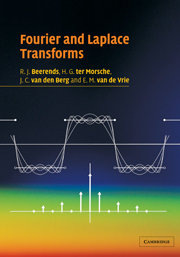Book contents
- Frontmatter
- Contents
- Preface
- Introduction
- Part 1 Applications and foundations
- Part 2 Fourier series
- Part 3 Fourier integrals and distributions
- Part 4 Laplace transforms
- 11 Complex functions
- 12 The Laplace transform: definition and properties
- 13 Further properties, distributions, and the fundamental theorem
- 14 Applications of the Laplace transform
- Part 5 Discrete transforms
- Literature
- Tables of transforms and properties
- Index
13 - Further properties, distributions, and the fundamental theorem
Published online by Cambridge University Press: 05 June 2012
- Frontmatter
- Contents
- Preface
- Introduction
- Part 1 Applications and foundations
- Part 2 Fourier series
- Part 3 Fourier integrals and distributions
- Part 4 Laplace transforms
- 11 Complex functions
- 12 The Laplace transform: definition and properties
- 13 Further properties, distributions, and the fundamental theorem
- 14 Applications of the Laplace transform
- Part 5 Discrete transforms
- Literature
- Tables of transforms and properties
- Index
Summary
INTRODUCTION
In the first three sections of this chapter the number of properties of the Laplace transform will be extended even further. We start in section 13.1 with the treatment of the by now well-known convolution product. As for the Fourier transform, the convolution product is transformed into an ordinary product by the Laplace transform.
In section 13.2 we treat two theorems that have not been encountered earlier in the Fourier transform: the so-called initial and final value theorems for the Laplace transform. The initial value theorem relates the ‘initial value’ f(0+) of a function f(t) to the behaviour of the Laplace transform F(s) for s → ∞. Similarly, the final value theorem relates the ‘final value’ limt→∞f(t) to the behaviour of F(s) for s → 0. Hence, the function F(s) can provide information about the behaviour of the original function f(t) shortly after switching on (the value f(0+)) and ‘after a considerable amount of time’ (the value limt→∞f(t)).
In section 13.3 we will see how the Laplace transform of a periodic function can be determined. It will turn out that this is closely related to the Laplace transform of the function which arises when we limit the periodic function to one period.
In order to determine the Laplace transform of a periodic function, it is not necessary to turn to the theory of distributions. This is in contrast to the Fourier transform (see section 9.1.2).
- Type
- Chapter
- Information
- Fourier and Laplace Transforms , pp. 288 - 309Publisher: Cambridge University PressPrint publication year: 2003

